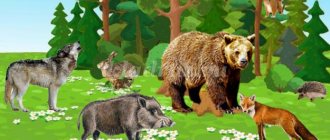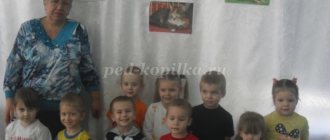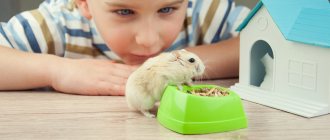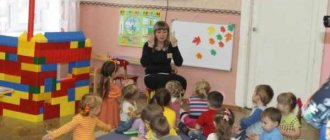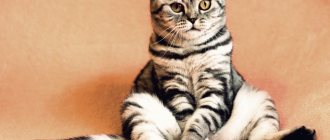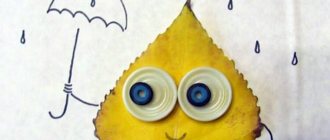Progress of the lesson.
Educator: Children, do you like to travel? (Children's answers)
Today we will take a train trip to the village.
On the way we will pass through the forest. Who can tell me who we can meet in the forest? (Fox, wolf, bear, deer, hedgehog, hare)
.
What are the names of all these animals ? (Wild)
.
Educator: That's right, Timur, these animals are called wild . Do you think we can meet these animals in the village? (No)
.
Educator: Why can’t we meet them?
Children: Because they are wild animals and live in the forest .
Educator: That's right, then who will we meet in the village?
Children: Cow, horse, sheep, pig, chicken, cat, dog, duck.
Educator: That's right, well done. Animals that live in the forest are called wild, and those that live in the village are called wild. ( Homemade )
. Why are they called that?
Children: Because they live next to people, and people take care of them and their offspring.
Educator: That's right, well done. I suggest you play the game “What’s missing?”
The teacher hangs several pictures of animals . Then the children close their eyes. One picture is removed. Children open their eyes and say which picture is missing.
“Where do they live? The teacher’s story about where pets
Educator: Do you know that these animals can be in large and small quantities. If there are many horses, it is called a herd; if there are many pigs, it is called a herd; if there are many cows, it is called a herd.
A herd is a lot...; a herd is a lot...; a flock is a lot...; a flock is a lot...
Physical education minute “Khomka”
Hammer, Hammer, Hamster, (circular movements on the stomach )
Striped barrel. (straight movements on the sides)
Khomka gets up early, (stretch)
Washes the neck (imitation of washing the neck)
Rubs cheeks. (rub cheeks with fists)
Khomka cleans the hut (imitation sweeping)
And goes out to exercise: (walk in place)
One, two, three, four, five (arms forward, up, forward, to the sides, down)
Khomka wants to become strong. (show how strong Khoma is)
Teacher's story about the benefits of animals .
-What animal guards the house (dog)
-Who catches mice? (cat)
-What animals give milk (goat, cow)
-Which animal wool is used to make clothing (goat, sheep, rabbit)
Educator: Well done, you know a lot about pets . And now we will try to describe the cow.
Children, together with the teacher, describe the cow according to the plan: what size is it; what color it is; characteristic features of body parts; where he lives; what does it eat; what benefits does it bring to people?
A cow is a large animal . It comes in black, white, brown. The cow has long legs, a tail, and a mane. She lives in a barn, eats grass, hay, gives milk and meat.
Summary of the lesson .
-Did you like our trip?
-What were we talking about?
-What will you tell your parents about?
-What did you like most?
Summary of an integrated lesson on cognitive development in the senior group “Pets” Summary of an integrated lesson on cognitive development in the senior group on the topic “Pets” Objectives: Expand and consolidate.
Summary of educational activities on speech development in the middle group topic: “Wild and domestic animals” Purpose: To summarize children’s knowledge on the topic. Educational objectives: To consolidate ideas about domestic and wild animals; Clarify, expand, etc.
Notes on speech development in the middle group “Domestic and wild animals” Goals: Expanding vocabulary and consolidating knowledge about domestic and wild animals in preschool children. Program content:.
Notes in the second early age group on cognitive development “Pets” Notes in the second early age group on cognitive development on the topic “Pets” Purpose: To consolidate children’s knowledge about pets. Summary of a lesson on cognitive development for children of the junior group “Pets and their cubs” Summary of a lesson on cognitive development for children of the junior group “Pets and their cubs” If you meet a cow, do not be afraid.
Summary of a lesson on cognitive development in the middle group “Wild animals in winter” Purpose: To create conditions for the formation of ideas about how wild animals adapt to changing weather conditions. Tasks:.
"Pets". Summary of a lesson on speech development for the middle group “Sounds of the surrounding reality” Objectives: • To learn to distinguish the sounds of the surrounding reality “Pets”; • Development of auditory attention, memory; • Development of speech on.
GCD on cognitive development in the middle group “Pets. Journey to a village farmstead" Implementation of the program content in educational areas: "Cognitive development", "Artistic and aesthetic development", "Speech development".
"Pets". Notes on cognitive development in the second junior group. Notes on cognitive development in the second junior group on the topic: “Grandma Matryona and her pets.” Prepared and conducted.
Organized educational activities on cognitive development for the middle group “Pets” Objectives: 1. Develop memory, logical thinking, voluntary attention, activate children’s vocabulary. 2. Reinforce previously studied material.
Source
Development of notes for a drawing lesson in the middle group
The drawing lesson includes three stages of working on the topic:
- introductory - up to 3 minutes - the teacher motivates the children to work, that is, updates their knowledge on the topic;
- main - up to 12 minutes - the teacher describes the procedure for completing the task, the children draw, to relieve muscle tension in the middle of the creative process, finger exercises and/or physical education are performed;
- final - up to 3 minutes - the teacher organizes a spontaneous exhibition of works, praises the kids for their drawings, children evaluate their works according to the “like/dislike” criterion and try to say why.
Table: Antonova M.V. Summary of a drawing lesson on the topic “Kitten” in the middle group
| Stage | Content |
| Introductory | Educator: - Guys, a guest came to us today, he asked not to name him. He wants to play the game “Recognize by Voice” with you. Let's try to recognize our guest? I turn on a recording of the cat's voice. A cat appears. Educator: (on behalf of the cat) - Hello, guys! Let's introduce ourselves, my name is Dymok. (Children say their names.) Teacher: (on behalf of the cat) - I came to you today for a reason. I want to ask you for help. My cat friends have a birthday soon. I wanted to please them, to draw them holiday cards with my friends on them. But I have many friends, but little time. Maybe you guys can help me? Educator: - What, guys, should we help Dymka? (Yes, we will help.) Educator: (on behalf of the cat) - Thank you very much for not refusing my request. Educator: - Smokey, but we don’t know what your friends look like. Educator: (on behalf of the cat) - I have photographs of them. Look! I place pictures of cats with different colored fur on the easel. Children look at the “photos”. |
| Basic | Educator: - Guys, go to the tables and choose pictures with pictures of kittens. Children sit at tables and choose coloring pictures. |
| Educator: - Guys, so that the fur of our kittens is fluffy, we will paint with a glue brush. Touch it, what does it feel like? (Hard, solid, rough) Educator: - Guys, look at how we will draw the kittens’ fur. We hold the brush correctly, the handle of the brush should be directed upward, the movements should be jerky. First, we use a poke to draw the shape of the cat along the contour, then, using a poke, we paint over the entire body of the cat. We put a little paint on the brush. When the cat is painted with a soft brush, you can complete the postcard as you wish. It could be: the sun, grass, flowers, sky, butterfly. Do you guys all understand how to draw? Then start drawing. Children draw, the teacher controls the drawing process, helps children in need. | |
| Final | Educator: - Guys, Dymka liked all your cards. And as a farewell, he wants to play the game “Cat and Mice” with you: Children stand in a circle, holding hands. The teacher sits on a chair in the center of the circle with a cat toy. Children walk in a circle and say words. The mice are dancing in a circle, The cat is dozing on the bed - Quiet the mouse, don’t make noise, Don’t wake Vaska the cat! When Vaska the cat wakes up, he will break up the whole round dance! The cat catches up with the children, the children run away to the chairs. |
| Quote from: https://ped-kopilka.ru/blogs/marija-vasilevna-antonova/konspekt-nod-po-risovaniyu-v-srednei-grupe-kotenok.html | |
